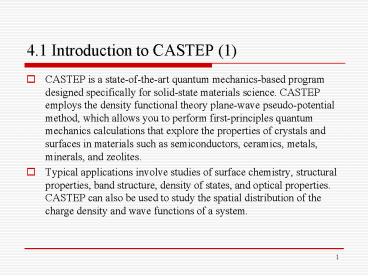4'1 Introduction to CASTEP 1 - PowerPoint PPT Presentation
1 / 9
Title:
4'1 Introduction to CASTEP 1
Description:
Typical applications involve studies of surface chemistry, structural properties, ... choose a better element as a B-site dopant in SrTiO3 to lower the oxygen ion ... – PowerPoint PPT presentation
Number of Views:752
Avg rating:3.0/5.0
Title: 4'1 Introduction to CASTEP 1
1
4.1 Introduction to CASTEP (1)
- CASTEP is a state-of-the-art quantum
mechanics-based program designed specifically for
solid-state materials science. CASTEP employs the
density functional theory plane-wave
pseudo-potential method, which allows you to
perform first-principles quantum mechanics
calculations that explore the properties of
crystals and surfaces in materials such as
semiconductors, ceramics, metals, minerals, and
zeolites. - Typical applications involve studies of surface
chemistry, structural properties, band structure,
density of states, and optical properties. CASTEP
can also be used to study the spatial
distribution of the charge density and wave
functions of a system.
2
4.1 Introduction to CASTEP (2)
- CASTEP can be used effectively to study
properties of both point defects (vacancies,
interstitials, and substitutional impurities) and
extended defects (e.g., grain boundaries and
dislocations) in semiconductors and other
materials. - Furthermore, the vibrational properties of solids
(phonon dispersion, total and projected density
of phonon states, thermodynamic properties) can
be calculated with CASTEP using either the linear
response methodology or the finite displacements
technique. The results can be used in various
ways, for instance, to investigate the
vibrational properties of adsorbates on surfaces,
to interpret experimental neutron spectroscopy
data or vibrational spectra, to study phase
stability at high temperatures and pressures,
etc. The linear response method can also be used
to calculate the response of a material to an
applied electric field - polarizability for
molecules and dielectric permittivity in solids -
and to predict IR spectra.
3
4.2 Modeling
- Figure 4.1. Model for the motion energy
calculation. - Supercell with an extra oxygen vacancy.
- Supercell with a oxygen ion located at the saddle
point.
4
4. 3 Choosing Parameters
- The structural parameters were calculated by
geometry optimization with high accuracy from
first principles. - Calculations of the total energy of the systems
were carried out using the pseudo-potential
method. - All static calculations were performed using the
CASTEP code with ultra soft pseudo-potentials and
the Perdew-Burke-Ernzerhof (PBE) GGA exchange
correlation term. - The ultra-find convergence of the total energy
and the energy cutoff were chose. - Spin polarization was taken into account in this
study.
5
4. 4 Examples
- Example 1 migration energy of oxygen ion in the
BaCo0.875B0.125O3(B Sc, Mn, Ni, Fe, Co, Y, Nb,
In, Sn)
Figure 4.2 Migration energy of oxygen ion in the
BaCo0.875B0.125O3 system
6
4. 4 Examples
- Example 2migration energy of oxygen ion in the
Ba0.875A0.125CoO3(A La, Sr, Ba, Ca)
Figure 4.3 Migration energy of oxygen ion in the
Ba0.875A0.125CoO3 system
7
4. 4 Examples
- Example 3 Calculation for oxygen ion migration
in SrBO3 - The aim of calculation was to choose a better
element as a B-site dopant in SrTiO3 to lower the
oxygen ion migration energy and thus increase the
oxygen ion conductivity. The ion migration energy
was referred to as the activation energy for
oxygen ion conduction. The ion migration energies
in SrBO3 (BSc, Ti, V, Cr, Mn, Fe, Co, Ni, Zn,
Ga, Ge, As, Zr, Nb, Mo, Tc, Ru, Rh, Pd, Cd, In,
Sn and Sb)
8
Figure 4.4 Migration energy of oxygen ion in the
SrBO3 system
X. Li et al. / Electrochemistry Communications 10
(2008) 15671570
9
4.5 Testing Methods
- Electron-blocking method
- Thermogravimetric testing
- Concentration cell
- Chemical titration































